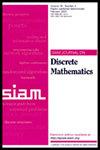小近似比随机分数分类的简单算法
IF 1
3区 数学
Q2 MATHEMATICS
引用次数: 0
摘要
SIAM 离散数学杂志》,第 38 卷第 3 期,第 2069-2088 页,2024 年 9 月。 摘要我们重温了 Gkenosis 等人(ESA 2018)提出的随机分数分类(SSC)问题:我们得到 [数学] 测试。每次测试 [math] 的成本为 [math],成功的概率为 [math]。此外,已知将(整数)区间 [math] 分割成 [math] 个更小的区间。我们的目标是进行测试,以便从分区中确定成功测试次数所在的区间,同时使预期成本最小化。Ghuge、Gupta 和 Nagarajan(IPCO 2022)最近指出,存在一种多项式时间恒因子近似算法。我们的研究表明,将这两种分别按[math]和[math]比率递增排列测试的策略交织在一起--正如 Gkensosis 等人针对一种特殊情况提出的那样--会产生较小的近似率。我们还证明,通过加入第三种策略,即简单地按成本递增排列测试,近似率可以从 6 略微降低到 [math]。这两种算法的类似分析并不复杂,但可以说都很简洁。最后,我们用 3/2 的下限补充了[math]中关于适应性差距的隐含上限。由于下限实例是所谓的单位成本[math]-of-[math]实例,因此我们解决了这种情况下的适应性差距。本文章由计算机程序翻译,如有差异,请以英文原文为准。
Simple Algorithms for Stochastic Score Classification with Small Approximation Ratios
SIAM Journal on Discrete Mathematics, Volume 38, Issue 3, Page 2069-2088, September 2024.
Abstract. We revisit the Stochastic Score Classification (SSC) problem introduced by Gkenosis et al. (ESA 2018): We are given [math] tests. Each test [math] can be conducted at cost [math], and it succeeds independently with probability [math]. Further, a partition of the (integer) interval [math] into [math] smaller intervals is known. The goal is to conduct tests so as to determine that interval from the partition in which the number of successful tests lies while minimizing the expected cost. Ghuge, Gupta, and Nagarajan (IPCO 2022) recently showed that a polynomial-time constant-factor approximation algorithm exists. We show that interweaving the two strategies that order tests increasingly by their [math] and [math] ratios, respectively—as already proposed by Gkensosis et al. for a special case—yields a small approximation ratio. We also show that the approximation ratio can be slightly decreased from 6 to [math] by adding in a third strategy that simply orders tests increasingly by their costs. The similar analyses for both algorithms are nontrivial but arguably clean. Finally, we complement the implied upper bound of [math] on the adaptivity gap with a lower bound of 3/2. Since the lower-bound instance is a so-called unit-cost [math]-of-[math] instance, we settle the adaptivity gap in this case.
Abstract. We revisit the Stochastic Score Classification (SSC) problem introduced by Gkenosis et al. (ESA 2018): We are given [math] tests. Each test [math] can be conducted at cost [math], and it succeeds independently with probability [math]. Further, a partition of the (integer) interval [math] into [math] smaller intervals is known. The goal is to conduct tests so as to determine that interval from the partition in which the number of successful tests lies while minimizing the expected cost. Ghuge, Gupta, and Nagarajan (IPCO 2022) recently showed that a polynomial-time constant-factor approximation algorithm exists. We show that interweaving the two strategies that order tests increasingly by their [math] and [math] ratios, respectively—as already proposed by Gkensosis et al. for a special case—yields a small approximation ratio. We also show that the approximation ratio can be slightly decreased from 6 to [math] by adding in a third strategy that simply orders tests increasingly by their costs. The similar analyses for both algorithms are nontrivial but arguably clean. Finally, we complement the implied upper bound of [math] on the adaptivity gap with a lower bound of 3/2. Since the lower-bound instance is a so-called unit-cost [math]-of-[math] instance, we settle the adaptivity gap in this case.
求助全文
通过发布文献求助,成功后即可免费获取论文全文。
去求助
来源期刊
CiteScore
1.90
自引率
0.00%
发文量
124
审稿时长
4-8 weeks
期刊介绍:
SIAM Journal on Discrete Mathematics (SIDMA) publishes research papers of exceptional quality in pure and applied discrete mathematics, broadly interpreted. The journal''s focus is primarily theoretical rather than empirical, but the editors welcome papers that evolve from or have potential application to real-world problems. Submissions must be clearly written and make a significant contribution.
Topics include but are not limited to:
properties of and extremal problems for discrete structures
combinatorial optimization, including approximation algorithms
algebraic and enumerative combinatorics
coding and information theory
additive, analytic combinatorics and number theory
combinatorial matrix theory and spectral graph theory
design and analysis of algorithms for discrete structures
discrete problems in computational complexity
discrete and computational geometry
discrete methods in computational biology, and bioinformatics
probabilistic methods and randomized algorithms.

 求助内容:
求助内容: 应助结果提醒方式:
应助结果提醒方式:


